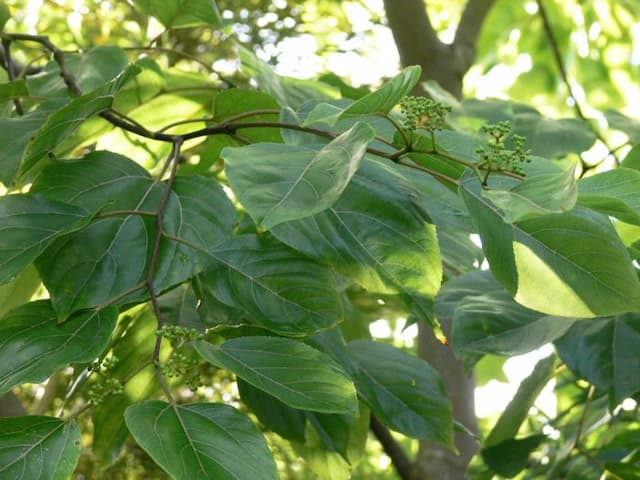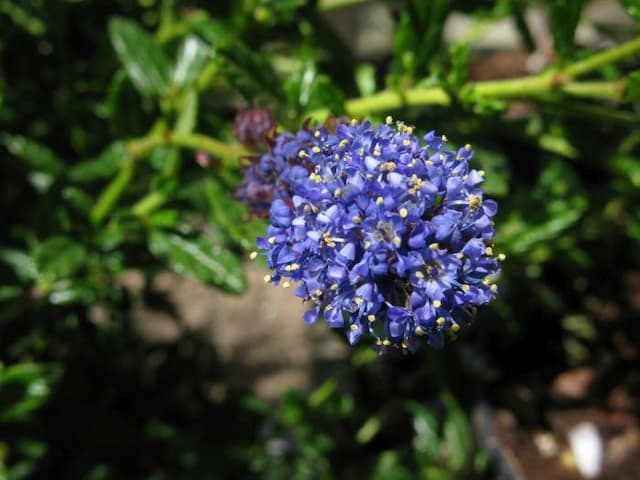Alder Buckthorn Frangula alnus

ABOUT
The plant commonly known as Alder Buckthorn is a deciduous shrub that boasts an array of features contributing to its distinctive appearance. It has somewhat glossy, green leaves that are oval-shaped with pointed tips and finely toothed margins, typically arranged in alternating patterns on the branches. During the spring and summer, the foliage provides a lush, dense canopy. As the seasons change, the leaves transform into a display of yellowish hues before they fall. Small, inconspicuous greenish-white flowers bloom in late spring, clustered in the leaf axils. These flowers, although not showy, are important for pollinators. By late summer to autumn, the flowers give way to small, round berries, which transition in color from red to a dark, purplish-black as they mature. The bark of the Alder Buckthorn is smooth and gray when young, but as the shrub matures, it becomes more textured with subtle ridges and furrows. The branches extend to form a dense, thicket-like arrangement, creating habitats for various species of birds and wildlife. The overall shape of the Alder Buckthorn is generally rounded, contributing to its bushy appearance. This plant can be recognized by its subtle features and changes through the seasons, providing ecological value and visual interest throughout the year, irrespective of its size.
About this plant
 Names
NamesFamily
Rhamnaceae.
Synonyms
Alder Buckthorn, Glossy Buckthorn, Fen Buckthorn, Breaking Buckthorn.
Common names
Rhamnus frangula, Frangula frangula, Frangula europaea, Frangula dodonei, Rhamnus alnifolia, Rhamnus frangula var. columnaris, Rhamnus frangula var. angustifolia, Rhamnus frangula var. pontica, Frangula alnus var. pontica, Frangula alnus subsp. pontica, Frangula alnus var. pubescens, Frangula alnus subsp. pubescens.
 Toxicity
ToxicityTo humans
Alder buckthorn is the plant in question. This plant is not considered highly toxic to humans; however, the berries can cause discomfort if ingested. Consuming the berries might lead to symptoms such as abdominal pain, nausea, vomiting, and diarrhea, as they have a mild laxative effect. Eating large amounts of the berries may lead to more serious gastrointestinal distress.
To pets
Alder buckthorn can also pose a toxicity risk to pets. Similar to humans, the primary concern is the ingestion of the berries, which can produce gastrointestinal symptoms like vomiting and diarrhea in animals due to their laxative properties. Although not usually life-threatening, ingesting large quantities can cause more severe digestive upset and should be avoided to prevent discomfort and potential dehydration.
 Characteristics
CharacteristicsLife cycle
Perennials
Foliage type
Deciduous
Color of leaves
Green
Flower color
Greenish-white
Height
15-20 feet (4.6-6 m)
Spread
10-15 feet (3-4.5 m)
Plant type
Shrub
Hardiness zones
3-7
Native area
Europe Asia
Benefits
 General Benefits
General Benefits- Erosion Control: Frangula alnus has an extensive root system that helps stabilize soil and prevent erosion.
- Wildlife Habitat: It provides shelter and food for various species of birds, insects, and other wildlife.
- Ornamental Use: With its attractive berries and foliage, Frangula alnus is often used for ornamental purposes in gardens and landscapes.
- Wood Production: The wood of Frangula alnus is dense and can be used for tool handles, turning, and carving.
- Hedging: Because of its dense growth, it can be pruned into an effective hedge.
- Privacy Screen: When grown densely, it can serve as a natural privacy screen for properties.
- Natural Dye: The bark contains tannin and can be used to produce a yellow dye.
- Low Maintenance: This plant is hardy and requires minimal care once established, making it ideal for low-maintenance landscaping.
- Biodiversity Support: It supports biodiversity by providing a habitat and food sources for a variety of organisms.
 Medical Properties
Medical Properties- Laxative: Frangula alnus bark contains compounds that have a laxative effect when consumed. It is often used for relieving constipation.
- Cholagogue: The plant has been used traditionally to stimulate bile production and aid in digestion.
- Anti-inflammatory: Some components in the bark may have anti-inflammatory properties.
 Air-purifying Qualities
Air-purifying QualitiesThis plant is not specifically known for air purifying qualities.
 Other Uses
Other Uses- Frangula alnus wood can be used for turning objects on a lathe; its fine grain allows for a smooth finish on items such as tool handles and small wooden crafts.
- The berries of the Alder Buckthorn are sometimes used as a natural dye, producing shades of green, yellow, or gray depending on the mordant used in the dyeing process.
- The bark of the Alder Buckthorn can be used in tanning leather, providing the tannins needed to cure and preserve animal hides.
- In traditional woodworking, Alder Buckthorn is valued for making veneer, a thin decorative covering of fine wood applied to coarser wood or other material.
- The dense and fine wood of the Alder Buckthorn is suitable for carving detailed small sculptures or intricate ornamental objects.
- Historically, the charcoal produced from Alder Buckthorn was used in the manufacture of gunpowder due to its high burn rate and low ash content.
- The plant's flexible and durable branches can be woven into baskets or used in the creation of natural fencing or garden structures.
- Alder Buckthorn can be grown as a hedging plant to create living fences or privacy screens in landscape design.
- Some beekeepers value Alder Buckthorn for its early flowering which provides an important source of pollen and nectar for bees in the spring.
- The smooth, stable wood of Alder Buckthorn is sometimes utilized in making musical instruments such as woodwind body parts where consistent density is desired.
Interesting Facts
 Feng Shui
Feng ShuiThe Alder Buckthorn is not used in Feng Shui practice.
 Zodiac Sign Compitability
Zodiac Sign CompitabilityThe Alder Buckthorn is not used in astrology practice.
 Plant Symbolism
Plant Symbolism- Protection: Alder buckthorn, as Frangula alnus is commonly known, has been used to make a red dye which, historically, could symbolize protection against evil influences.
- Healing: The bark of the alder buckthorn has been used for its medicinal properties, symbolizing healing and the alleviation of various ailments.
- Purification: Corresponding to its use as a purgative, alder buckthorn represents cleansing and purification of the body.
- Transformation: The ability of the alder buckthorn to adapt to various environments and its use in changing the color of fabrics could symbolize transformation and adaptability.
 Water
WaterThe Alder Buckthorn, which is the common name for Frangula alnus, enjoys moist but well-drained soil, so it is important to strike a balance when watering. Generally, watering should be done when the top inch of soil feels dry to the touch. In the growing season, this might mean watering once or twice a week, depending on climate conditions, with possibly one gallon per watering for a young shrub. During the winter months, reduce the frequency as the plant's water needs decrease. Ensure that the water reaches deep into the root zone to encourage strong root development.
 Light
LightThe Alder Buckthorn prefers full sunlight to partial shade conditions for optimal growth. It thrives best in a spot that receives plenty of morning sunlight and is partially shaded in the hot afternoon hours, especially in warmer climates. When planting Alder Buckthorn as part of a landscape design, consider positioning it in an area that receives at least 4-6 hours of direct sunlight daily.
 Temperature
TemperatureAlder Buckthorns are hardy and can tolerate a wide range of temperatures, performing best in areas with temperatures ranging from 35°F to 75°F. They are known to withstand minimum winter temperatures down to -30°F without significant damage. Ideally, maintaining the temperature around 60°F to 70°F would promote healthy growth for Alder Buckthorn.
 Pruning
PruningPruning Alder Buckthorn is mostly done to shape the plant or remove any dead, diseased, or crossed branches. The best time for heavier pruning is late winter or early spring before new growth starts. Thinning out older branches every few years helps to rejuvenate the plant. Annual light pruning to maintain the desired shape can be done after the plant has finished flowering.
 Cleaning
CleaningNot needed
 Soil
SoilAlder buckthorn thrives in well-draining soil with a pH of 5.5 to 7.5. A blend of loamy soil, sand, and peat is suitable to ensure adequate drainage and fertility. Incorporating organic matter like compost can also enhance soil structure for optimal plant health.
 Repotting
RepottingAlder buckthorn typically doesn't require frequent repotting; it can be done every 2-3 years. Check if the roots have outgrown the pot; if they have, it's time to repot into a slightly larger container.
 Humidity & Misting
Humidity & MistingAlder buckthorn prefers moderate humidity levels but is adaptable and can tolerate the varying humidity levels typically found in natural outdoor environments.
 Suitable locations
Suitable locationsIndoor
Place in bright, indirect light and keep soil moist.
Outdoor
Plant in partial shade; water regularly to maintain moist soil.
Hardiness zone
3-7 USDA
 Life cycle
Life cycleFrangula alnus, commonly known as alder buckthorn, begins its life cycle with seed germination, typically in the spring after a period of cold stratification that breaks seed dormancy. Seedlings emerge and grow into juvenile plants, initially developing a deep taproot and then a branching root system. Over the next few years, the plant matures into an adult, with woody stems and a height that can reach up to 5 meters, forming a shrubby, branched habit. Flowers develop in late spring to early summer, small and inconspicuous, which are insect-pollinated and lead to the formation of round, berry-like fruits. Once pollinated, the flowers form red-to-black berries, each containing seeds that are dispersed by birds and mammals. The alder buckthorn can live for many years, during which it will continue to grow, flower, and produce seeds in a perennial cycle.
 Propogation
PropogationPropogation time
Spring to early summer
The most popular method of propagating the Alder Buckthorn, Frangula alnus, is through its seeds. Propagation time typically starts in the fall after the seeds have matured. Fresh seeds have a higher germination rate and should be sown as soon as they are ripe. To propagate by seed, one would collect the berries when they're black and remove the seeds from the pulp. It's often advised to sow the seeds in a cold frame as soon as they are extracted. The cold frame creates a microclimate that offers protection from extreme weather and keeps the temperature slightly warmer than the outside environment, which is beneficial for the germination of seeds. The seeds require a period of cold stratification, which mimics the natural winter conditions the seeds would experience in the wild, to break dormancy and enhance germination rates when spring arrives.









